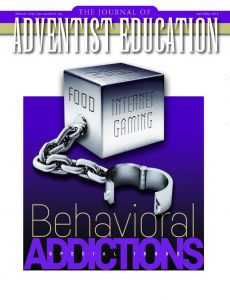Internet gaming. Exercise. Pornography. Food. What do these have in common? All can be the object of behavioral addiction. Beginning with Julian Melgosa’s editorial titled Behavioral Addictions: A Growing Trend, Volume 78, Issue 4 of the Journal of Adventist Education is devoted to this important topic. Other articles include:
Understanding Behavioral Addictions by Julian Melgosa
Melgosa explains the definition and scope of behavioral addictions, noting that substance addictions and behavioral addictions may be related to a single underlying disorder, as the two have very similar symptoms. The article also discusses the costs of behavioral addictions, the reasons that behavioral addictions are difficult to overcome, and the general types of prevention and treatment suitable for a wide variety of addictions.
 Biological Aspects of Addictive Behavior by Austin Archer
Biological Aspects of Addictive Behavior by Austin Archer
Archer states that, “This article will provide an overview of the biological processes that accompany chemical addictions and review the evidence that these processes also accompany behavioral addictions. I will then suggest reasons why these behaviors are so resistant to change, and discuss the role of choice in the ways in which these addictions manifest themselves. I will finally suggest how neurological processes and faith might intersect as we consider the phenomenon of addiction.”
Addressing Behavioral Addictions in Adolescents: Creating a School-wide Culture of Prevention by Tron Wilder and Steven Baughman
“What, then, is the best course of action for educators when a student is struggling with a behavioral addiction?” Wilder and Baughman describe recent research on behavioral addiction in adolescents and argue that schools should focus on prevention instead of punishment. The article provides strategies for preventing behavioral addictions and discusses four specific types of support useful for helping students struggling with behavioral addictions.
Preventing Food Addiction in Adolescents by Leslie Martin and Shelly McCoy
This article provides an overview of research on addictive-like eating, including criteria for food addictions in children. A variety of strategies for addressing maladaptive eating behaviors are described, including developing positive relationships between students and staff and limiting the unhealthy options available on school grounds, among others.
Recognizing and Avoiding Potential Triggers for Internet Gaming Addiction by Linda Ivy
Ivy notes that “parents and educators should be alert for warning signs throughout the elementary and secondary years, and help young people learn to manage their game-playing behavior before they are on their own.” The article provides information about the nature, prevalence and risk factors, development and etiology, consequences, and prevention methods related to Internet Gaming Addiction. Also included are suggestions for school personnel, an overview of strategies used by mental-health professionals, and a discussion of the relevance of Internet Gaming Addiction for Adventist teachers, along with a list of warning signs of problematic gaming.
Caught in the ‘Net’ – Recognizing Internet Addiction in Youth by Mary Varghese and Carlos Fayard
“Internet addiction refers to a pathological use of computers or technology that is characterized by intrusive urges to engage in online behaviors to an extent that contributes to significant impairments in daily life.” The authors discuss the six core factors of internet addiction and provide a chart of warning signs for internet addiction in children. In addition, they explain the prevalence, risk factors, negative consequences, and evidence-based prevention and intervention programs for internet addiction.
No More Secrets: Talking with Children and Young Adults about Pornography by Brad Hinman
This article provides an overview of the patterns, risk factors, and consequences of Internet pornography addiction and discusses appropriate personal and institutional responses, including discussing pornography with children at a young age in combination with other sexual and health topic. Christians are at higher risk for Internet pornography addictions than other groups, so addressing these issues with our children is particularly important. The article provides resources for ensuring student safety online, preventing online victimization, and learning more about Internet pornography addiction.
Helping Students Experience the Healthful Benefits of Exercise by Tammy Bovee and Amanda Gunn
“Educators, school personnel, and parents need to be aware of the warning signs and behaviors of exercise addiction in order to plan a timely intervention. Schools can provide students with guidelines regarding balancing healthy exercise amounts with other necessary activities so they can take a holistic approach when they become responsible for creating their own daily schedule.” To help in reaching that goal, this article discusses the symptoms and warning signs of exercise addiction, along with the prevalence, risk factors, development and etiology, as well as suggestions for school personnel and a summary of strategies used by mental health professionals.


1 comments